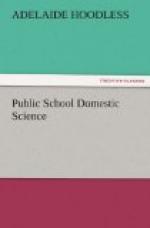Foods Containing Protein, or Nitrogenous Matter.
Animal foods contain nutritive matter in a concentrated form, and being chemically similar to the composition of the body is doubtless the reason why they assimilate more readily than vegetable foods, although the latter are richer in mineral matter. The most valuable animal foods in common use are meat, eggs, milk, fish, gelatin and fats.
MEAT.
Meat is composed of muscular tissue, connective tissue or gristle, fatty tissue, blood-vessels, nerves, bone, etc. The value of meat as food is due chiefly to the nitrogenous compound it contains, the most valuable being the albuminoids: the gelatinoid of meat is easily changed into gelatin by the action of hot water. Gelatin when combined with the albuminoids and extractives has considerable nutritive value. Extractives are meat bases, or rather meat which has been dissolved by water, such as soup stock and beef tea. The object in cooking meat is to soften and loosen the tissue, which renders it more easily digested. Another object is to sterilize or kill any germs which may exist and to make it more palatable. The digestibility of meat is influenced by the age of the animal killed and the feeding. The following table is given as an average of the digestibility of animal foods:—
TABLE OF COMPARATIVE DIGESTIBILITY.
Commencing with the most digestible and ending with the least digestible of meats and other animal foods. (Thompson.)
Oysters.
Soft cooked eggs.
Sweetbread.
Whitefish, etc.
Chicken, boiled or broiled.
Lean roast beef or beefsteak.
Eggs, scrambled, omelette.
Mutton.
Bacon.
Roast fowl, chicken, turkey,
etc.
Tripe, brains, liver.
Roast lamb.
Chops, mutton or lamb.
Corn beef.
Veal.
Duck and other game.
Salmon, mackerel, herring.
Roast goose.
Lobster and crabs.
Pork.
Fish, smoked, dried, pickled.
Cooking affects the digestibility of meat, which is evident from the figures given in the following table (Church):—
TIME OF DIGESTION.
--------------------+---------------- | Hours. --------------------+---------------- Beef, raw | 2 Beef, half boiled | 2-1/2 Beef, well boiled | 2-3/4 to 3 Beef, half roasted | 2-3/4 to 3 Beef, well roasted | 2-1/4 to 4 Mutton, raw | 2 Mutton, boiled | 3 Mutton, roasted | 3-1/4 Veal, raw | 2-1/2 Pork, raw | 3 Pork, roasted | 5-1/4 Fowl, boiled | 4 Turkey, boiled | 2-1/2 Venison, broiled | 1-1/2 --------------------+----------------
It may be well to add here that animal food is more digestible when cooked between 160 deg. and 180 deg. F. than at a higher temperature.




